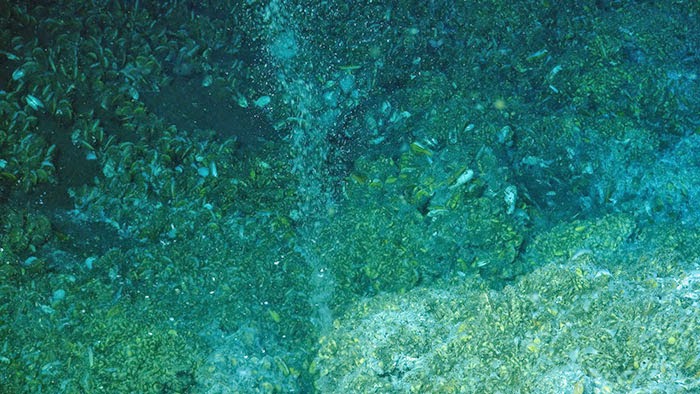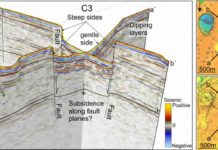
In 2011, Jennifer Glass joined a scientific cruise to study a methane seep off of Oregon’s coast. In these cold, dark depths, microbes buried in the sediment feast on methane that seeps through the seafloor.
A product of their metabolism, bicarbonate, reacts with calcium in seawater to form tall rocky deposits. The chemical energy these organisms extract from methane supports a vibrant underworld—an eclectic blanket of microbial mats, clam fields and tube worms.
“It’s such a beautiful landscape,” says Glass, an alumnus of NASA’s Astrobiology post-doctoral program and now assistant professor at the Georgia Institute of Technology. “You have these huge mountains on the sea floor, housing these incredible ecosystems.”
In March, Glass presented some of her work on methane and microbes in the second lecture for NASA’s Astrobiology Postdoctoral Program seminar series. In her talk, “Microbes, Methane, and Metals,” Glass discussed the importance of metals as nutrients for these microbes.
Glass’s work has a broader implication for understanding greenhouse gas cycles and climate change. Methane is a greenhouse gas that is approximately 25 times more potent than carbon dioxide. Recently, atmospheric methane has been increasing after a decade-long hiatus. While scientists aren’t entirely sure why, they suspect a combination of methane-producing microbes in wetlands and the warming of high latitude permafrost. What’s more, recent findings suggest that methane-spewing microbes may have contributed to our Earth’s biggest extinction, the “Great Dying,” 250 million years ago.
The methane-eating microbes that Glass studies play an important role in the methane cycle, keeping in check additional release of methane from cold seeps, where it is stored as an ice-like structure that slowly trickles through the sea floor.
Glass first learned about these ecosystems while studying oceanography in college, and quickly became fascinated by them. “I could gush poetically,” she says, offering the link to a long piece she wrote for the magazine Northwest Science and Technology in 2006 (Methane Mimosas on Ice).
But she did not get to work on them until years later, when she became an Astrobiology NPP postdoc in the lab of Victoria Orphan, a geobiologist at the California Institute of Technology. On her first day, Glass and her new colleagues boarded the RV Atlantis on a scientific expedition off of Oregon’s coast. Using the Remotely Operated Vehicle Jason, they collected microbes and sediments from the sea floor.
From these samples emerged a surprising discovery.
The group found evidence of a new microbial enzyme that seems to use the trace metal tungsten instead of molybdenum, the metal more commonly found in cold seep environments. Previously, tungsten had only been found in microbes living at high temperatures, such as the boiling waters of hydrothermal vents. The group’s findings were published last year in the journal Environmental Microbiology.
“It’s a very unique chemical environment, with a lot of sulfur,” Glass says. “We think that tungsten might just be more bio-available in these highly sulfidic conditions.”
“Overall, we’re hoping to get a better understanding of alternative pathways of greenhouse gas cycling,” she says. “Our main goal here was to understand how the environment in these deep sea methane seeps influences microbe metabolism, and specifically the trace-metal chemistry. And no one had really looked into these specific chemicals before.”
In collaboration with colleagues at Georgia Tech as well as Sean Crowe of the University of British Columbia and David Fowle of the University of Kansas, Glass has now begun new studies in Lake Matano, Indonesia as an analogue for oceans on early Earth. The deep waters of Lake Matano are poor in oxygen and rich in iron and methane, factors likely characteristic of ancient oceans.
“We’re looking to pull out unique microbes from these sediments,” she says. “And so far, the evidence suggests that microbes may be coupling methane and iron redox cycles to survive at the bottom of Lake Matano.”
While excessive methane release in the atmosphere could be catastrophic for life today, it may not always have been the case. On early Earth, our Sun was 30 percent fainter than it is today. Scientists believe that atmospheric methane may have kept the Earth warm enough to prevent water from freezing, enabling the emergence and evolution of early life.
What’s more, these systems don’t depend on oxygen, Glass explains. So the microbe-methane relationship likely developed early in Earth’s history before the rise of oxygen.
They could also serve as analogues for worlds beyond our Earth. Methane has been detected in the atmosphere of other planets. Methane lakes have also been spotted on Titan, Saturn’s largest moon, making it an intriguing candidate for life elsewhere.
Note : The above story is based on materials provided by Astrobio










